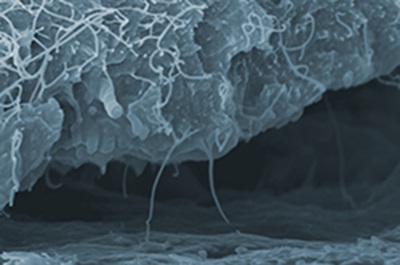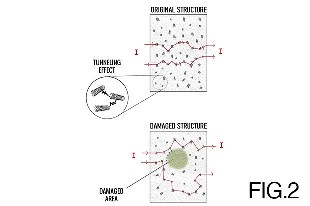
Composite materials are increasingly replacing traditional metallic materials even in safety-critical structures, due to their excellent specific mechanical properties, i.e. higher strength-to-weight and stiffness-to-weight ratios, as well as due to their improved resistance to corrosion, their fire-retardant properties, and the reduced lifecycle costs. However, especially in the case of out-of-plane (impact) and compression loads, composite materials are subjected to complex degradation mechanisms including, for example, matrix cracking and delamination. This behaviour strongly depends on the material configuration and the operating condition, thus making damage evolution less predictable, and potentially turning into increased operative costs for maintenance.
A lot of research is devoted to the implementation of structural health monitoring systems, typically based on the installation of permanent sensors providing a continuous stream of data. Signal processing and artificial intelligence algorithms are then used for detection, assessment, and prognosis of damage during the operative life of a component or a structural part. However, on one hand, the application of dense sensor networks over structures often induces significant weight increase hampering the advantage of adopting composite materials; on the other hand, many sensor technologies only provide a local measure of some variables (e.g. the strain) that are correlated with damage features.
To overcome these limitations, the Department of Mechanical engineering of Politecnico di Milano, in the framework of the Young Researcher program, has funded the research project MISTICO (Monitoring of composite material structures with carbon nanotubes - 2016-2019). The project team, led by Prof. Claudio Sbarufatti as Principal Investigator, combines the background experience in different research lines within the department, including Machine and Vehicle Design (Proff. Claudio Sbarufatti and Flavia Libonati) for structural health monitoring, damage degradation and nanocomposites, Measurements (Dr. Diego Scaccabarozzi), for sensor design and signal processing optimisation and Dynamics and Vibration (Prof. Simone Cinquemani), for smart materials and structural control.
The ground idea of MISTICO is that of exploiting the multifunctional properties of epoxy-based nanocomposites reinforced with carbon nanoparticles to create a composite self-sensing structure. This is capable of detecting potential deterioration mechanisms within the material by a measure of its piezo-resistivity, potentially revolutionizing the concept of sensor network design. Adding carbon nanotubes (CNTs) into the matrix of composite material can have a dual effect. First, an increase of the fatigue life is noticed as nanotubes tend to “bridge” the crack edges limiting its evolution, as depicted in Fig. 1. Second, the addition of a very small quantity of CNTs into the non-conductive resin will provide piezo-resistive properties that can be exploited for self-sensing, without the installation of any sensor but turning the bulk material into a sensor itself. The latter concept is depicted in Fig. 2: tunnelling effect and contact among the CNTs allow the current flowing through the structure. When damage occurs, the CNTs distribution around the damage area changes, as the relative distance between the CNTs. Therefore, if a constant DC current is imposed, a change in the voltage will be noticed close to the damaged area, e.g. before and after the occurrence of an impact, which is related to the piezo-resistive variation across the specimen.
The approach has been first verified on fiber-reinforced composite specimens subjected to tensile loading (Fig. 3a), where the onset of micro damages was detected and validated with measurements by a thermal camera [1]. Secondly, CNTs have been sprayed on a film adhesive and used to monitor debonding on a lap joint subject to fatigue loads (Fig. 3b), proving the method is suitable not only to identify damage but also to capture the load variation across the specimen [2]. Thirdly, low-velocity impact tests were implemented to correlate the signals from multiple channels on a single composite plate specimen doped with multi-walled CNTs with the simultaneous measures of displacement and forces (Fig. 4), proving the possibility of identifying the delamination onset during damage and the dynamic oscillation after impact occurrence [3-6].
Thanks to the very promising results obtained, future activity by the team is devoted to the increase of robustness of the approach, leveraging the optimisation of the manufacturing process [7] to obtain repeatable performance, thus paving the way towards potential implementation of self-sensing for structural control [8].
[1] Park, K., Scaccabarozzi, D., Sbarufatti, C., Jimenez-Suarez, A., Ureña, A., Ryu, S., Libonati, F., Coupled health monitoring system for CNT-doped self-sensing composites (2020) Carbon, 166, pp. 193-204
[2] Sánchez-Romate, X.F., Sbarufatti, C., Sánchez, M., Bernasconi, A., Scaccabarozzi, D., Libonati, F., Cinquemani, S., Güemes, A., Ureña, A., Fatigue crack growth identification in bonded joints by using carbon nanotube doped adhesive films (2020) Smart Materials and Structures, 29 (3), art. no. 035032
[3] Sbarufatti, C., Sánchez-Romate, X.F., Scaccabarozzi, D., Cinquemani, S., Libonati, F., Güemes, A., Ureña, A. On the dynamic acquisition of electrical signals for structural health monitoring of carbon nanotube doped composites (2017) Proceedings of the 11th International Workshop on Structural Health Monitoring, IWSHM 2017, 2, pp. 1921-1928.
[4] Sbarufatti, C., Simón, P., Cinquemani, S., Scaccabarozzi, D., Impact analysis of fiber-reinforced composites by means of carbon nanotubes (2018) Proceedings of SPIE - The International Society for Optical Engineering, 10595, art. no. 1059538.
[5] X.F. Sánchez-Romate, C. Sbarufatti, D. Scaccabarozzi, S. Cinquemani, A. Jiménez-Suárez, A. Güemes and A. Ureña, Monitoring of impact dynamics on carbon nanotube multiscale glass fiber composites by means of electrical measurements, Proc. SPIE 10170, Health Monitoring of Structural and Biological Systems 2017, 101703A (April 5, 2017).
[6] Scaccabarozzi, D., Cinquemani, S., Sbarufatti, C., Jimenez-Suarez, A., Sanchez, M., Urena, A. A preliminary study on self sensing composite structures with carbon nanotubes (2017) 4th IEEE International Workshop on Metrology for AeroSpace, MetroAeroSpace 2017 - Proceedings, art. no. 7999613, pp. 434-438.
[7] Esmaeili, A., Sbarufatti, C., Jiménez-Suárez, A., Hamouda, A.M.S., Rovatti, L., Ureña, A., Synergistic effects of double-walled carbon nanotubes and nanoclays on mechanical, electrical and piezoresistive properties of epoxy based nanocomposites (2020) Composites Science and Technology, 200, art. no. 108459
[8] Cinquemani, S., Simón, P., Scaccabarozzi, D., Sbarufatti, C., Cazzulani, G., Exploiting self sensing features of carbon nanotubes composite structures for active vibration control (2018) Proceedings of SPIE - The International Society for Optical Engineering, 10595, art. no. 105952A.




